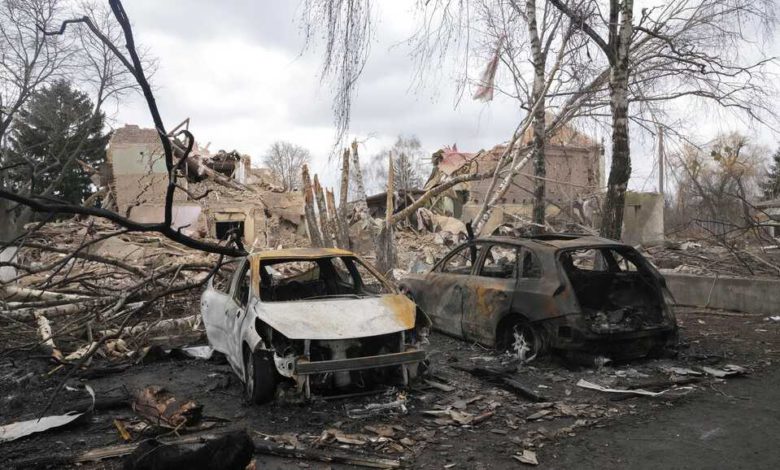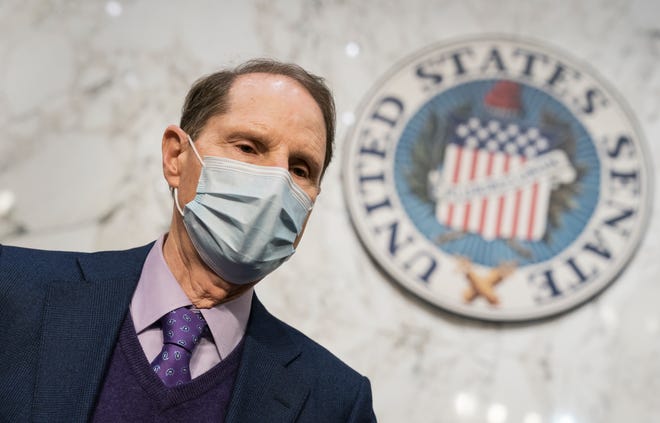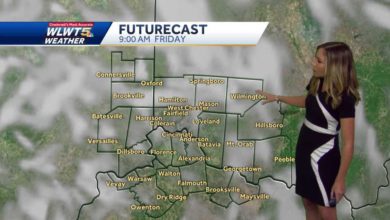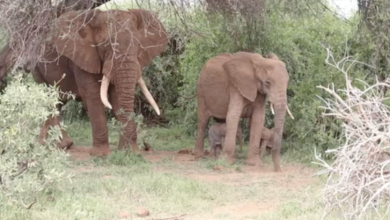

The Russian military initiated a temporary cease-fire in two areas of Ukraine to allow civilians to evacuate, Russian state media reported Saturday, the first breakthrough in allowing people to escape the war.The Russian Defense Ministry said in a statement it had agreed on evacuation routes with Ukrainian forces for the strategic port of Mariupol in the southeast and the eastern city of Volnovakha. The vaguely worded statement did not make clear how long the routes would remain open.Here's the latest on the Ukraine-Russia conflict as of 5 a.m. (Eastern):The office of President Emmanuel Macron says France will soon propose concrete measures to ensure the safety and security of Ukraine’s five main nuclear sites.The U.N. Security Council will hold an open meeting Monday on the worsening humanitarian situation in Ukraine as the Russian offensive intensifies.The U.S. Embassy in Ukraine is calling Russia's attack on a nuclear plant a war crime. Russian troops seized the plant Friday in an attack that set it on fire and briefly raised fears of a nuclear disaster. The blaze was extinguished and no radiation was released. The White House announced Friday that U.S. Vice President Kamala Harris will travel to Poland and Romania next week to meet with officials to discuss the Russian invasion of Ukraine and impact the war is having on the region.Mariupol had become the scene of growing misery amid days of shelling that knocked out most phone service and raised the prospect of food and water shortages.Pavlo Kirilenko, head of the Donetsk military-civil administration that includes Mariupol, said the humanitarian corridor would extend from the city to Zaporizhzhia, about 140 miles away.The head of Ukraine’s security council, Oleksiy Danilov, had urged Russia to create humanitarian corridors to allow children, women and the older adults to flee the fighting, calling them “question No. 1.”As Russian forces batter strategic locations elsewhere, Ukrainian President Volodymyr Zelenskyy has lashed out at NATO for refusing to impose a no-fly zone over his country, warning that “all the people who die from this day forward will also die because of you.”NATO said a no-fly zone could provoke widespread war in Europe with nuclear-armed Russia. But as the United States and other NATO members send weapons for Kyiv and more than 1 million refugees spill through the continent, the conflict is already drawing in countries far beyond Ukraine’s borders. Russia continues to crack down on independent media reporting on the war, also blocking Facebook and Twitter, and more outlets say they are pausing their work inside the country.And in a warning of a hunger crisis yet to come, the U.N. World Food Program says millions of people inside Ukraine, a major global wheat supplier, will need food aid “immediately.”Ukraine’s president was set to brief U.S. senators Saturday by video conference as Congress considers a request for $10 billion in emergency funding for humanitarian aid and security needs.Video: Photos show Ukrainians fleeing as Russia presses onIn a bitter and emotional speech late Friday, Zelenskyy criticized NATO over the lack of a no-fly zone, warning that “the history of Europe will remember this forever.”A no-fly zone would bar all unauthorized aircraft from flying over Ukraine.NATO Secretary General Jens Stoltenberg earlier in the day ruled out that possibility. “The only way to implement a no-fly zone is to send NATO fighter planes into Ukrainian airspace, and then impose that no-fly zone by shooting down Russian planes,” he said. “We understand the desperation, but we also believe that if we did that, we would end up with something that could end in a full-fledged war in Europe.”In a separate video message to antiwar protesters in several European cities, Zelenskyy appealed for help. “If we fall, you will fall,” he said.The U.N. Security Council scheduled an open meeting for Monday on the worsening humanitarian situation. The United Nations estimates that 12 million people in Ukraine and 4 million fleeing to neighboring countries in the coming months will need humanitarian aid.Russia's attack on Friday on Ukraine's largest nuclear power plant, in Zaporizhzhia, caused global alarm, but Russian forces did not make significant progress in their offensive to sever Ukraine’s access to the Black Sea and the Sea of Azov, which would deal a severe blow to the country's economy.A vast Russian armored column threatening Ukraine’s capital remained stalled outside Kyiv, but Russia's military has launched hundreds of missiles and artillery attacks on cities and other sites across the country.Video: Pentagon calls Russian nuclear plant attack recklessUkrainian presidential adviser Oleksiy Arestovich said battles involving airstrikes and artillery continued northwest of Kyiv, and the northeastern cities of Kharkiv and Okhtyrka came under heavy fire. He said Ukrainian forces held the northern city of Chernihiv and the southern city of Mykolaiv and had defended the biggest port city, Odesa, from Russian ships.As homes in Chernihiv burned from what locals described as Russian shelling, one resident accused Europe of merely looking on. “We wanted to join NATO and the EU and this is the price we are paying, and NATO cannot protect us," she said.More than 840 children have been wounded in the invasion, and 28 have been killed, according to Ukraine’s government. At least 331 civilians have been confirmed killed, but the true number is probably much higher, the U.N. human rights office said.Kyiv’s central train station remained crowded with people desperate to join the more than 1.2 million who have fled Ukraine. “People just want to live,” one woman, Ksenia, said.
The Russian military initiated a temporary cease-fire in two areas of Ukraine to allow civilians to evacuate, Russian state media reported Saturday, the first breakthrough in allowing people to escape the war.
The Russian Defense Ministry said in a statement it had agreed on evacuation routes with Ukrainian forces for the strategic port of Mariupol in the southeast and the eastern city of Volnovakha. The vaguely worded statement did not make clear how long the routes would remain open.
Here's the latest on the Ukraine-Russia conflict as of 5 a.m. (Eastern):
- The office of President Emmanuel Macron says France will soon propose concrete measures to ensure the safety and security of Ukraine’s five main nuclear sites.
- The U.N. Security Council will hold an open meeting Monday on the worsening humanitarian situation in Ukraine as the Russian offensive intensifies.
- The U.S. Embassy in Ukraine is calling Russia's attack on a nuclear plant a war crime. Russian troops seized the plant Friday in an attack that set it on fire and briefly raised fears of a nuclear disaster. The blaze was extinguished and no radiation was released.
- The White House announced Friday that U.S. Vice President Kamala Harris will travel to Poland and Romania next week to meet with officials to discuss the Russian invasion of Ukraine and impact the war is having on the region.
Mariupol had become the scene of growing misery amid days of shelling that knocked out most phone service and raised the prospect of food and water shortages.
Pavlo Kirilenko, head of the Donetsk military-civil administration that includes Mariupol, said the humanitarian corridor would extend from the city to Zaporizhzhia, about 140 miles away.
The head of Ukraine’s security council, Oleksiy Danilov, had urged Russia to create humanitarian corridors to allow children, women and the older adults to flee the fighting, calling them “question No. 1.”
As Russian forces batter strategic locations elsewhere, Ukrainian President Volodymyr Zelenskyy has lashed out at NATO for refusing to impose a no-fly zone over his country, warning that “all the people who die from this day forward will also die because of you.”
NATO said a no-fly zone could provoke widespread war in Europe with nuclear-armed Russia. But as the United States and other NATO members send weapons for Kyiv and more than 1 million refugees spill through the continent, the conflict is already drawing in countries far beyond Ukraine’s borders.
Russia continues to crack down on independent media reporting on the war, also blocking Facebook and Twitter, and more outlets say they are pausing their work inside the country.
And in a warning of a hunger crisis yet to come, the U.N. World Food Program says millions of people inside Ukraine, a major global wheat supplier, will need food aid “immediately.”
Ukraine’s president was set to brief U.S. senators Saturday by video conference as Congress considers a request for $10 billion in emergency funding for humanitarian aid and security needs.
Video: Photos show Ukrainians fleeing as Russia presses on
In a bitter and emotional speech late Friday, Zelenskyy criticized NATO over the lack of a no-fly zone, warning that “the history of Europe will remember this forever.”
A no-fly zone would bar all unauthorized aircraft from flying over Ukraine.
NATO Secretary General Jens Stoltenberg earlier in the day ruled out that possibility. “The only way to implement a no-fly zone is to send NATO fighter planes into Ukrainian airspace, and then impose that no-fly zone by shooting down Russian planes,” he said. “We understand the desperation, but we also believe that if we did that, we would end up with something that could end in a full-fledged war in Europe.”
In a separate video message to antiwar protesters in several European cities, Zelenskyy appealed for help. “If we fall, you will fall,” he said.
The U.N. Security Council scheduled an open meeting for Monday on the worsening humanitarian situation. The United Nations estimates that 12 million people in Ukraine and 4 million fleeing to neighboring countries in the coming months will need humanitarian aid.
Russia's attack on Friday on Ukraine's largest nuclear power plant, in Zaporizhzhia, caused global alarm, but Russian forces did not make significant progress in their offensive to sever Ukraine’s access to the Black Sea and the Sea of Azov, which would deal a severe blow to the country's economy.
A vast Russian armored column threatening Ukraine’s capital remained stalled outside Kyiv, but Russia's military has launched hundreds of missiles and artillery attacks on cities and other sites across the country.
Video: Pentagon calls Russian nuclear plant attack reckless
Ukrainian presidential adviser Oleksiy Arestovich said battles involving airstrikes and artillery continued northwest of Kyiv, and the northeastern cities of Kharkiv and Okhtyrka came under heavy fire. He said Ukrainian forces held the northern city of Chernihiv and the southern city of Mykolaiv and had defended the biggest port city, Odesa, from Russian ships.
As homes in Chernihiv burned from what locals described as Russian shelling, one resident accused Europe of merely looking on. “We wanted to join NATO and the EU and this is the price we are paying, and NATO cannot protect us," she said.
More than 840 children have been wounded in the invasion, and 28 have been killed, according to Ukraine’s government. At least 331 civilians have been confirmed killed, but the true number is probably much higher, the U.N. human rights office said.
Kyiv’s central train station remained crowded with people desperate to join the more than 1.2 million who have fled Ukraine. “People just want to live,” one woman, Ksenia, said.
Source link








